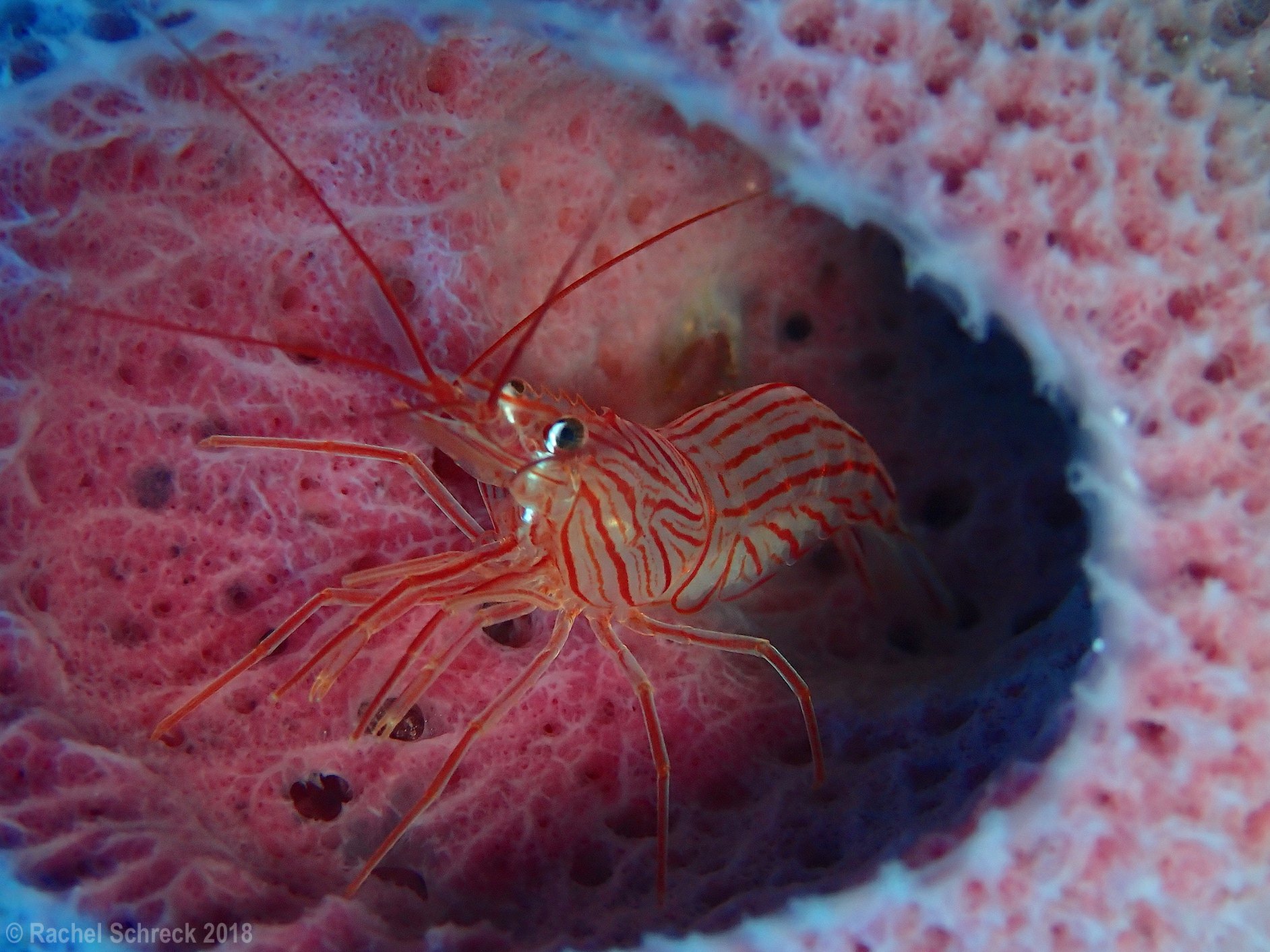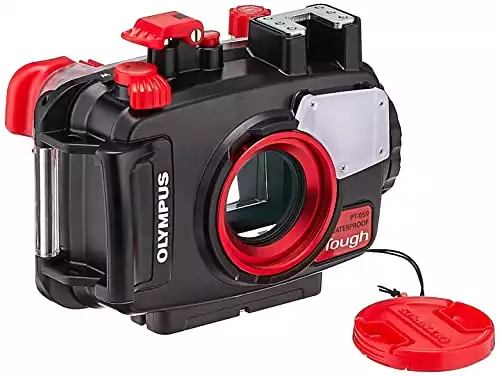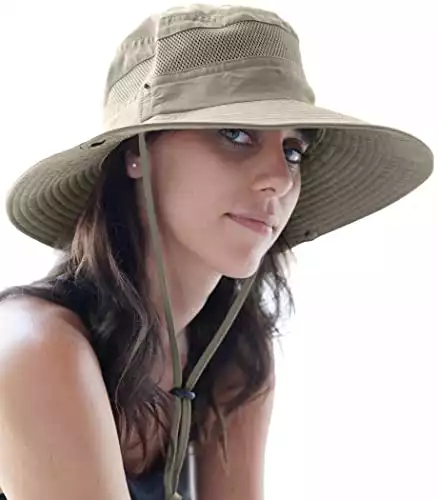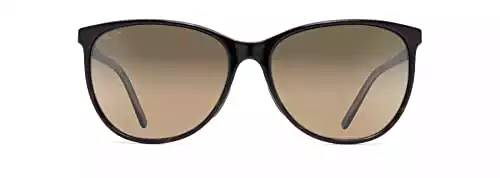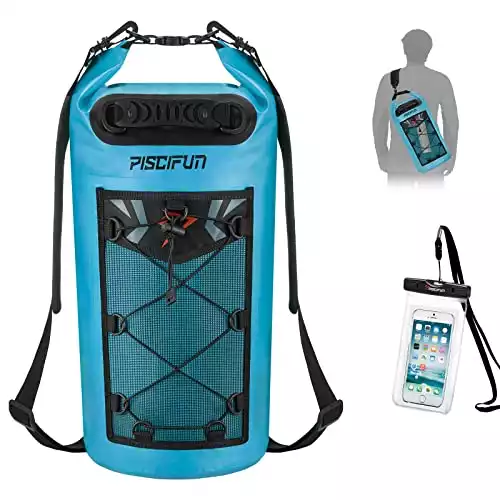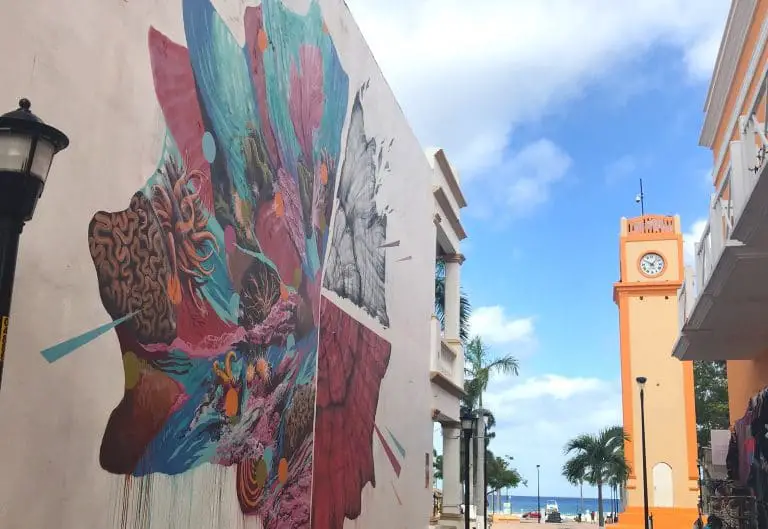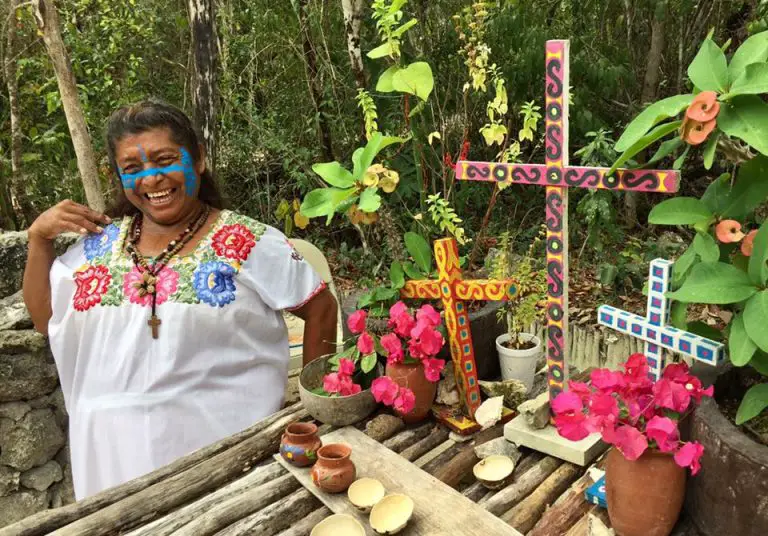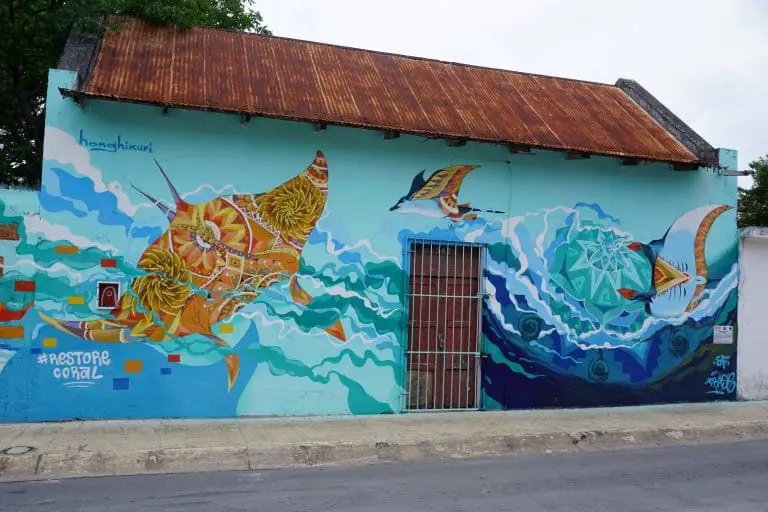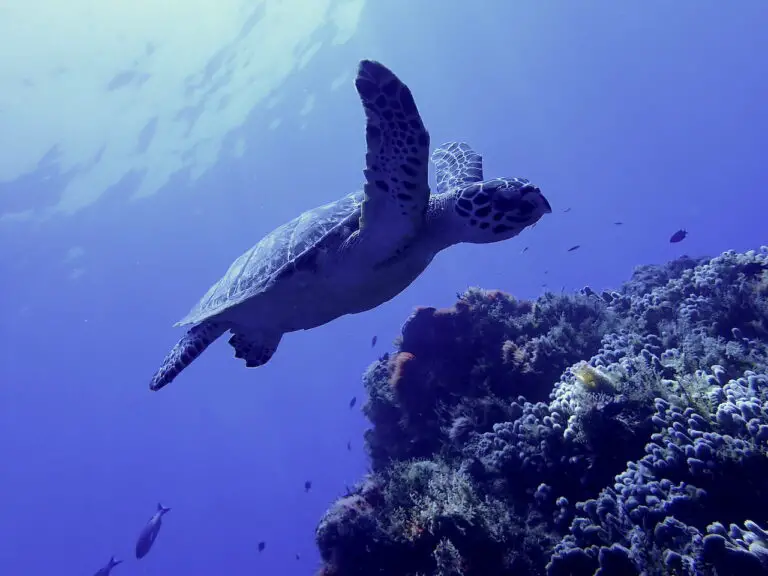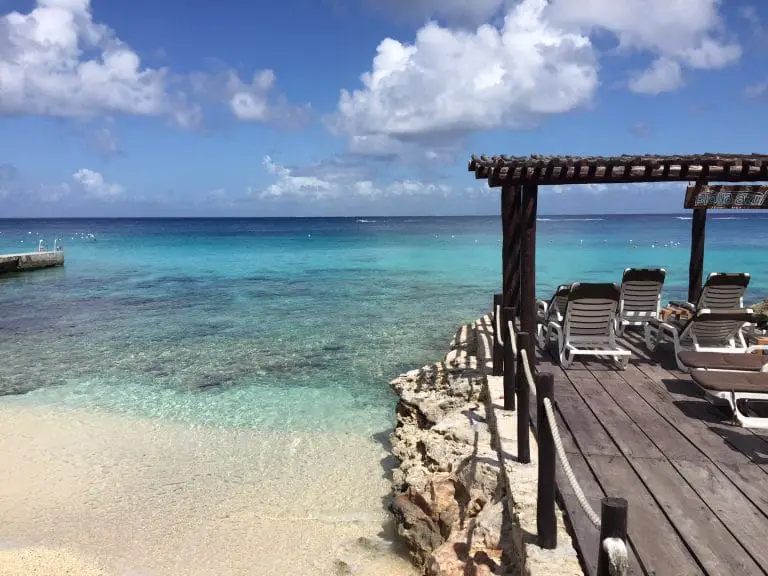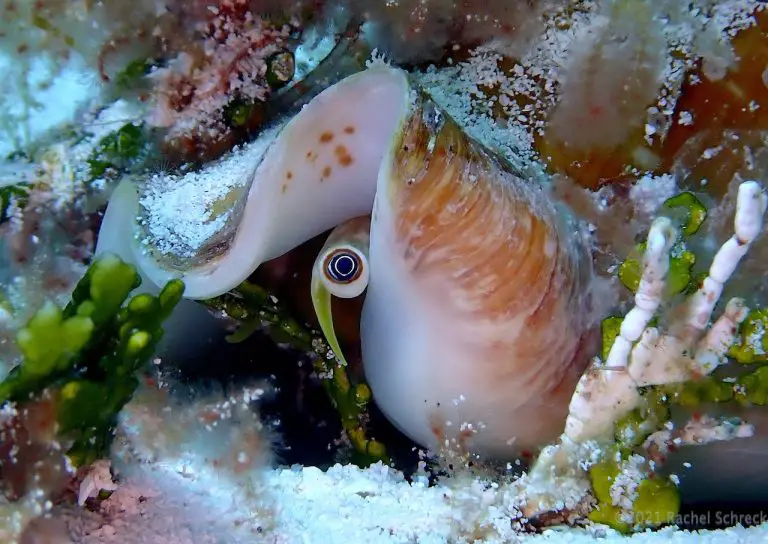9 Tips to Ace Your Cozumel Underwater Photography on Every Dive
Cozumel, Mexico is a world leader in scuba diving destinations and an excellent place to hone your hobby of taking underwater photos – whether you’re a budding beginner or a literal pro.
And in case you haven’t noticed, there are now thousands of underwater photo social media posts to prove it!
As a local Cozumel diving and dive photography enthusiast, I can attest to the range of awesome underwater landscapes and marine life subjects this stellar dive destination has to offer.
Cozumel reliably offers warm diving temps, and consistently clear water visibility averaging 100ft, making for superior
You might just have to relax, get a few tips on where to look, and give up the notion that only certain dive sites here have the “best” marine life.
Regardless of particular dive sites, if you know where to look, and can get used to adapting to the day’s lighting and current conditions, Cozumel diving will have you happily snapping hundreds of cool, framable and brag-worthy underwater dive pics – and filling up those memory cards – literally every month of the year.
Drift Diving Might Take Some Getting Used To
Tip #1 – Don’t Let Cozumel’s Reputation for “Drift Diving” Freak You Out
Literally just the other day, a newly minted Cozumel diver posted on a local social media page here full of frustration over the fact that Cozumel (even though it is a known ‘drift diving’ area) was way too hard.
He was certain that “no one” could achieve good buoyancy and trim, and that it was “pointless” to even try to enjoy his dives here. He was ready for a refund.
Well, hundreds of kind and reassuring responses, simple tips from legions of local divers, and only ONE additional day of local drift diving later??
He amended his post and said – and I quote – “I get it now. I’m converted. This place is awesome.”
Yet another life-long Cozumel diving fan was born, and an angel got her wings. 😉
If you’re not used to drift diving at all yet, just don’t let it intimidate you. If anything, I’m going to bet you’re in for a very pleasant surprise.
IF you’re here for the first time, or considering a first dive trip to Cozumel, please start with this introductory post tips for getting comfortable with our awesome drift diving.
And then, review our full local Divers’ Guide on Cozumel Scuba Diving.
Tip #2 – Go With The Flow (Literally)
Cozumel is known for pretty consistent breezes and a steady light drift (a.k.a. currents).
Lots of people make it sound far more intimidating than it is.
Your boat captain and divemasters will always check each site to make sure it’s not out of control, but typically you’ll find just a nice mild nudge running from south to north, making the diving as easy as can be.
Sometimes, it gets a little stronger. Just relax and don’t fight it – turn to face the current and kick lightly, maybe dip down below a coral head for some protection, and just calmly stay with your group.
No biggie.
Once in a great while, there are dives during the year when the current is just kinda… too much. In those cases, your DM will expect you to pay attention in case she or he alters the route, to stay with your buddy and the group, keep a good eye on your air, and calmly ride it out.
Again, no biggie, but just pay attention to your surroundings and your training.
Tip #3 – If the Current is Too Strong, Let the Photography Go
It is NEVER worth touching or grabbing anything along the reef (and it’s against the national marine park rules you’re bound by, I might add), and this is especially if you’re touching the reef just so you can get your shot.
And no offense, but that difficult (and destructive) shot will probably stink, anyway, so… just let it go.
Sometimes it’s just not meant to be, and you cannot use your underwater camera as an excuse to damage sponges, corals, sandy areas – none of it. Just let it go.
And on a similar diving and/or diving photos ethical note, PLEASE don’t use your underwater camera as an excuse to hog excessive time with good marine life encounters and ruin someone else’s dive, either. Don’t be that person.
BUT When the Cozumel currents are good, they’re really good
Usually, though? The mild currents we have most of the time are just cool. They guide you along, let you stop all the mad kicking, slow down, and gently meander from one coral head to the next.
It’s good old lazy diving. And it’s relaxing and fun.
If you’re out along a deep wall site, for example, you’ll find yourself calmly peering into sponges or large masses of intricate lettuce coral with plenty of hiding spots to find harlequin pipefish, long-armed brittle sea stars, or a plethora of beautiful reef urchins.

Diving a garden site like the beautiful La Francesa, you could be gliding past pairs of pretty butterflyfish pecking on brain coral, or if you’re like me you’ll be checking under all the various coral outcroppings, looking for huge Caribbean lobsters, clutches of Sergeant Major’s purple eggs, one of several types of colorful cleaner shrimp. or the understated beauty of a horseshoe worm on some beautiful coral.
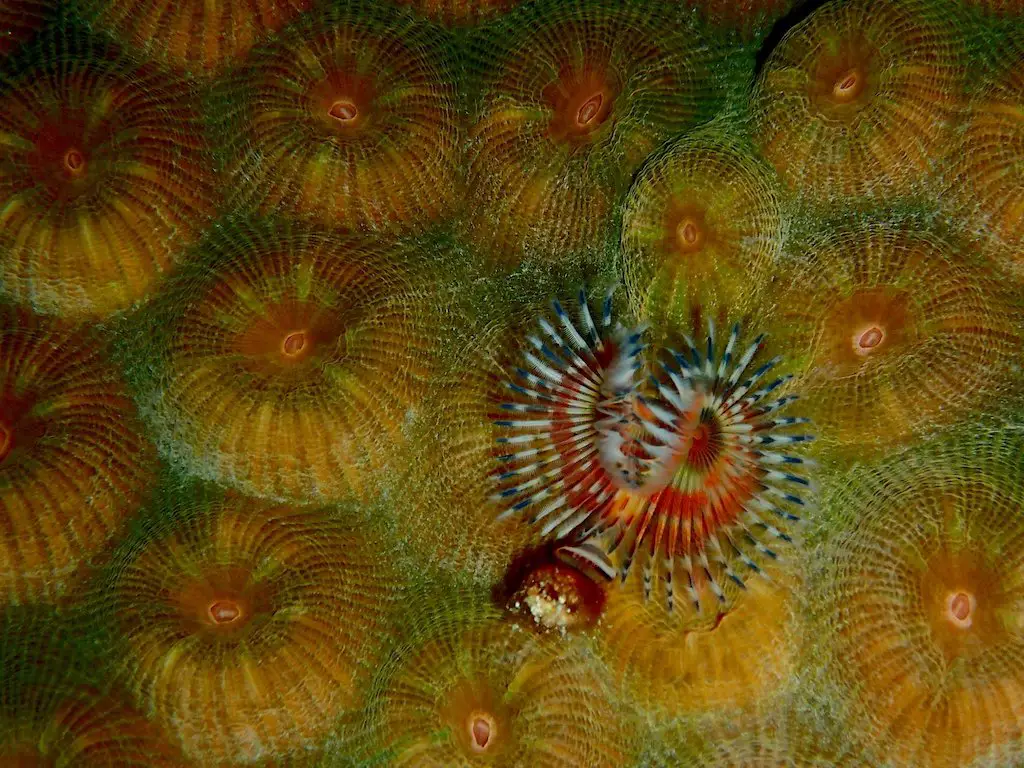
Crossing over the sand from the outer platform of San Clemente toward its incredibly active shallower reef, pay good attention!
Don’t assume these transitions are wasted time, by any means!
Divers in the know will be scouring that sandy bottom to find all kinds of fascinating marine life, like camouflaged scorpionfish, giant hermit crabs, burrowing lizardfish (a.k.a. “sand divers), sea slugs and nudibranchs, and hard to spot tiny juvenile flounder fish.

You might even catch the graceful fluttering of dancing jawfish hovering over their subterranean holes – look closely, and one of them might even be holding a clutch of eggs in its mouth, a practice known as mouth-brooding (read this feature marine life post for a little more about mouth-brooding and various Cozumel macro marine eggs).
The point is, no matter where you look in this stretch of the Mesoamerican reef chain, you could find some cute or creepy or colorful form of marine life worthy of your next proud Instagram moment.
And more importantly, please trust your extremely experienced Cozumel dive guides – they will always try to steer their dive groups to somewhere safe, but that also has cool stuff to see.
Marine life is all around us here.
You just have to make sure you have your favorite dive camera charged up and ready to go to take all those cool pictures of it!
Any Dive Site in Cozumel is a Good Dive Site
Tip #4 – Stop Believing There Are Only Certain “Good” Dive Sites in Cozumel
This kind of goes along with the section above.
For some reason, there are about 5 or 6 major dive sites that repeatedly get most of the good press in Cozumel.
And they’re great sites! We all love Palancar Caves, Santa Rosa Wall, Paso de Cedral, and so on.
But trust me. Everyone loves those sites, too, but they are definitely NOT the only game in town. Far from it.
The major coral formations, the deep gorgeous walls, wide platforms with crannies and crevasses, and endless types and sizes of marine life can be found on each and every Cozumel dive site.
You just never know! And that sense of wonder and “treasure hunting” is something I look forward to every single time I stride or back-roll off that boat to go diving in Cozumel.
I also feel that way as I wade in for a local shore dive to do some awesome Caribbean-style muck diving.
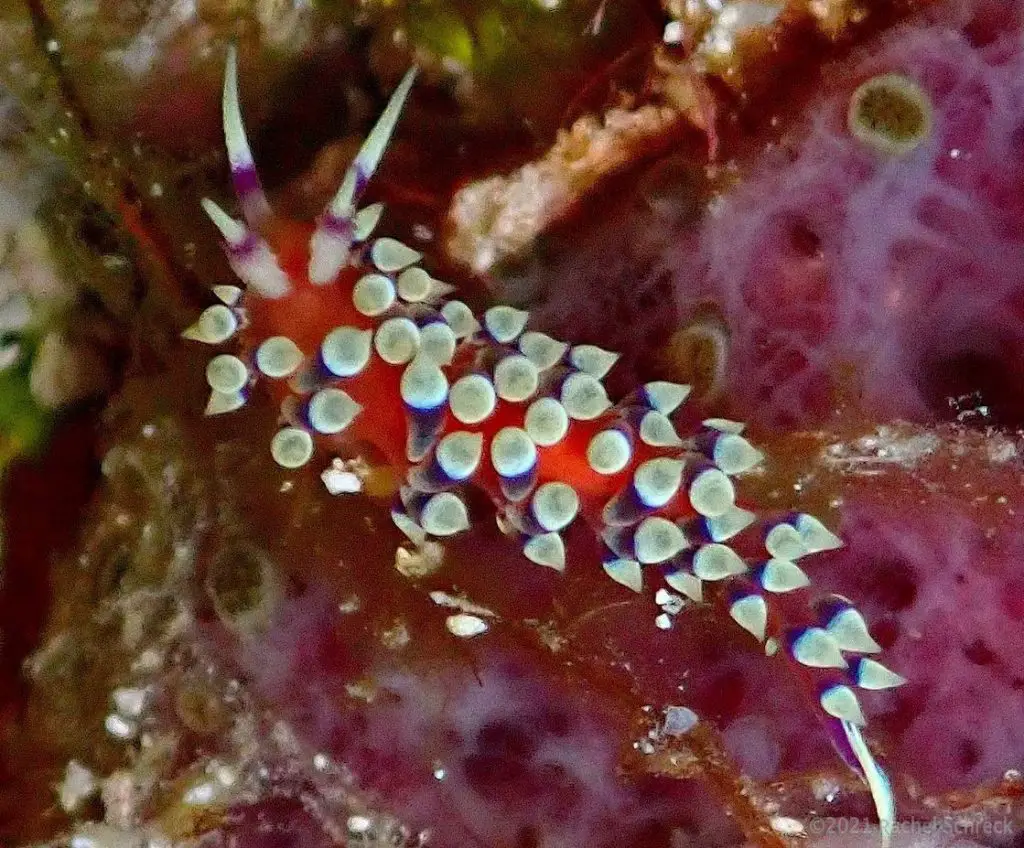
Cozumel Shore Diving
Shore diving in Cozumel is another thing that doesn’t get quite enough respect around here considering all the neat marine creatures you can see from shore.
That is changing especially with some of Cozumel’s cool specialized diving hotels like Casa Del Mar, Scuba Club Cozumel, and Blue Angel Resort reminding us of their great house reefs right outside your hotel doors. Ask them when you’re shopping for where to stay in Cozumel, too – usually some number of free shore dives and/or discounted tanks are usually part of their dive packages.
I’ve taken thousands of underwater photos in Cozumel, and captured a wide array of our local marine life, using both wide-angle shots as well as very tight macro settings.
And far more than half of those were not on the “top 5” sites that you often read about. FWIW.
Read more about the growing local shore diving scene here.
Tip #5 – Trust Your Captain, Divemaster, and Crew’s Assessment of the Day’s Conditions
The key to all of this is judging that particular day’s conditions.
From wind speed, wind direction, pending disturbances, and even the number of cruise ships or boat traffic on a given day, your Captain and your divemasters will do their best to get you diving on your chosen site.
However. IF there are too many other boats on a site, or the chop, currents, or visibility conditions could be poor, they’re doing you a huge favor when they suggest a potential alternate.
Go with it, and see what happens. There are no guarantees with marine life, but you might as well go with their years of experience and expertise to have the best and safest dive possible.
Cozumel Marine Life for Wide Angle Shooters
Cozumel’s Beautiful and Diverse Coral Formations
Some of the most beautiful images underwater photographers with great wide-angle rigs can capture are of the coral formations, themselves.
Deep mountainous reefs like Punta Sur, the Columbia reef chain, and the entire stretch of Cozumel’s famous Palancar reef sites give dive photographers a nearly endless panorama.
There are colorful coral landscapes, dreamy stretches of white sandy slopes sliding down between coral pinnacles to seeming oblivion of the deep, and gorgeous textured silhouettes of backlit sea fans, whips, and of course fish or turtles hovering along the infinite clear blue ocean.
The C-53 Wreck Dive
The Wreck, as it’s known (since we really only have one main purpose-sunk wreck site inside the Cozumel Marine Park area) is a fun, easily penetrable dive site, that has of course become not only a neat wreck experience but also somewhat of a good artificial reef.
The C-53, officially named the C53 Felipe Xicotencatl, was originally a US minesweeper, and later served as a patrolling gunboat for the Mexican Navy in the Gulf of Mexico.
As a macro photography lover, myself, when I dive the C53 I mainly scour the bow and pilothouse areas for neat macro critters like nudibranchs, juvenile angelfish, tube worms, and Pederson cleaner shrimp.
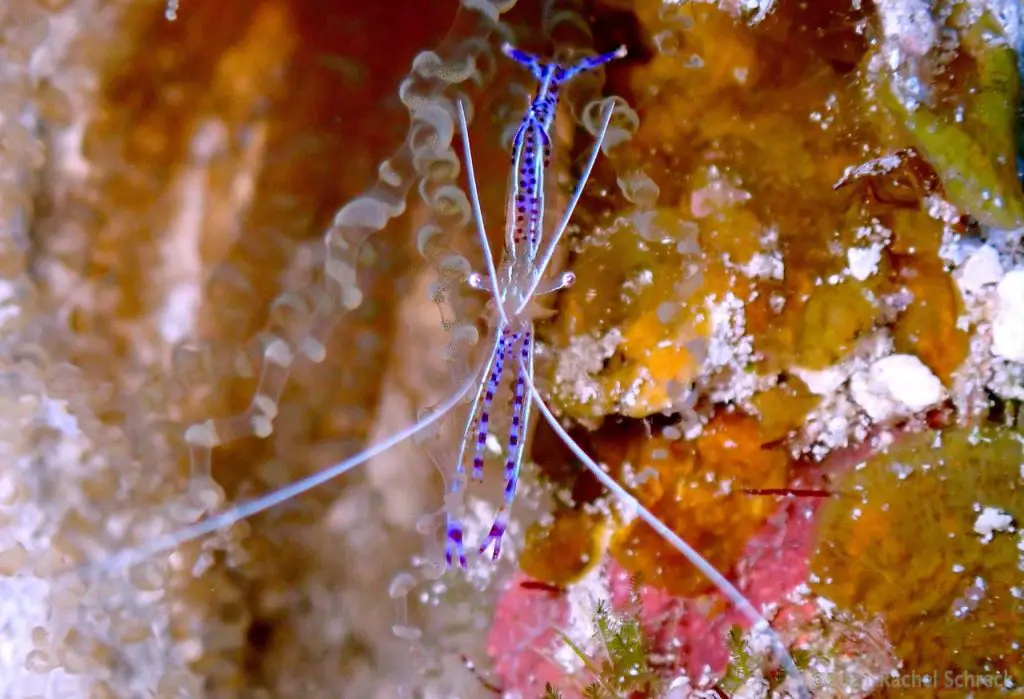
But the wreck itself makes a stunning wide-angle landscape shot on a clear sunny day, and there are other wide vantage points that many dive photographers here enjoy.
The wreck is home to large groupers that sometimes camp out under the stern end of the boat, and huge green moray eels sometimes take up residence in various rooms and cubbies of the ship.
Often, you may also get a fun shot at the nearby operator of the Atlantis Submarine excursion doing a drive-by – and delight its passengers with a friendly wave, and a nice photo of the sub.
Visit this full post about the C-53 Wreck dive in Cozumel for more information, here.
Large Animals and Marine Life in Cozumel
Spotted Eagle Rays
As for large marine life, Cozumel’s best-loved pelagics are the packs of majestic spotted eagle rays we are graced with primarily during their season from November through March.
That said, these two beauties – apparently a parent and one of its young – were cruising along San Francisco wall on a random sunny day in late July!
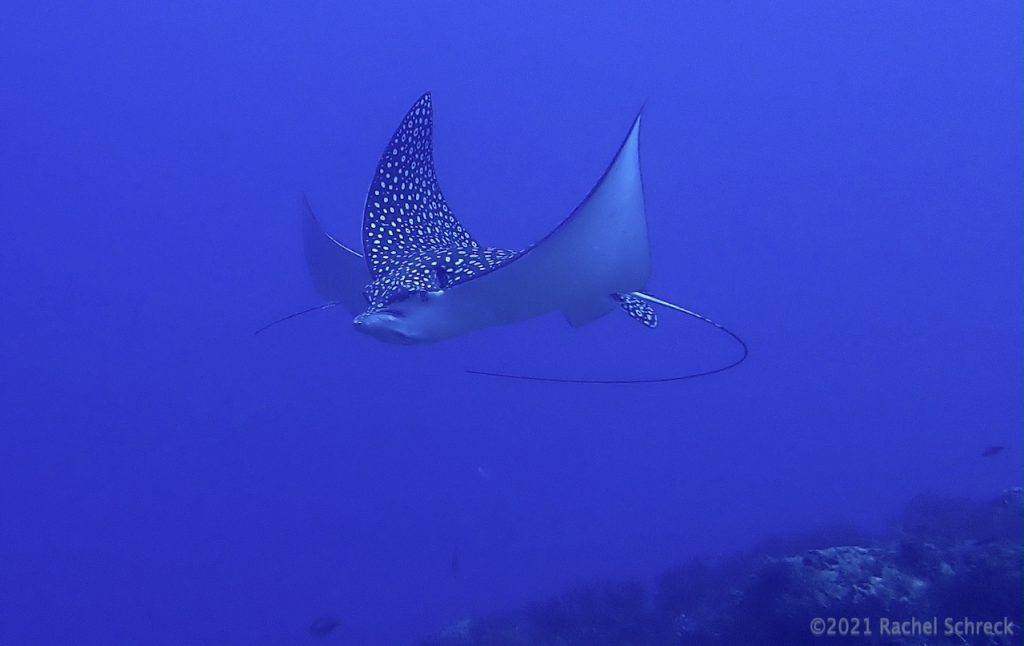
That’s the beauty of Cozumel – and of scuba diving, really – you just never know what you’re going to encounter. So best to keep that camera charged and ready.
Cozumel’s Shark Populations
Sharks are just plain awesome, after all.
Cozumel is primarily home to Atlantic Nurse Sharks, though there are occasional sightings of small blacktip sharks in the winter months, and often in the deeper wall dives in the southern area of the marine park, like Columbia Deep or Palancar Bricks.
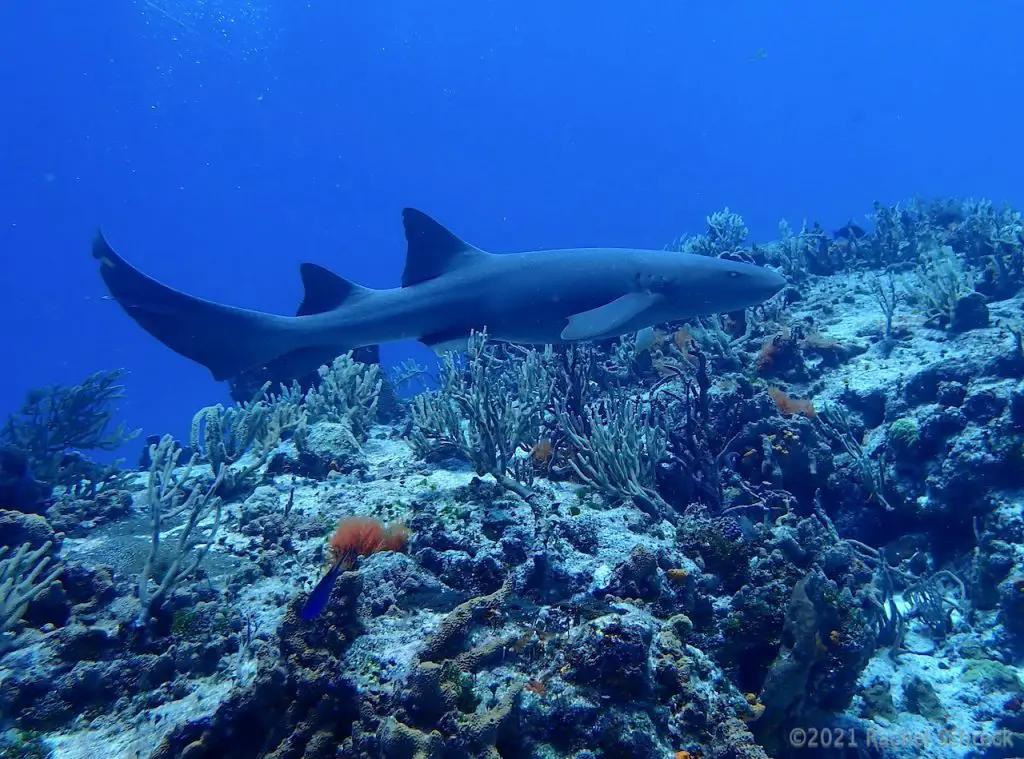
I’ve already covered the sharks in this area pretty well in this related article, but divers and photographers are of course enchanted with sharks, so go read more about them there, next.
Other Large Cozumel Marine Life
Moray eels and other marine eels.
Check out our full post on all the resident eels of Cozumel HERE.
Sea Turtles
Cozumel sea turtles are everyone’s favorite (of course, right?), and we’re lucky enough to have populations of hawksbill sea turtles, green sea turtles, and the revered loggerhead sea turtles.
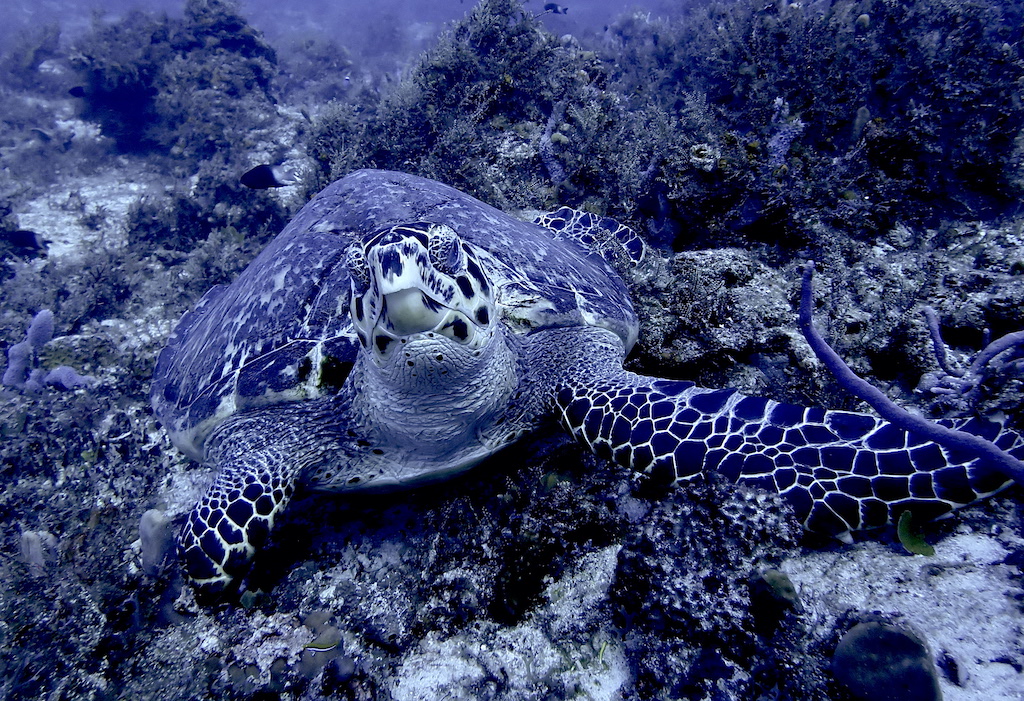
There is SO much about our local turtles, that I’d love it if you could visit and bookmark my full, comprehensive guide to all things Cozumel Sea Turtles can be found right HERE.
Stingrays
Stingrays are also very common in Cozumel and make for some awesome photos – especially if you’re looking for some good practice subjects.
Southern stingrays are especially large (and plentiful), and often found in the vast, sandy bottom areas between pinnacles down around Palancar Gardens, Palancar Caves, and Columbia, but also very often in the shallows of all the Cozumel reefs, like Yucab, Dalila, and Francesa, just to name a few.
They often like to bury themselves under the sand for some alone time, or maybe for a sneak attack – in which case, keep your eyes peeled for two eyes blinking in the white sand (and be mindful of that barbed tail).
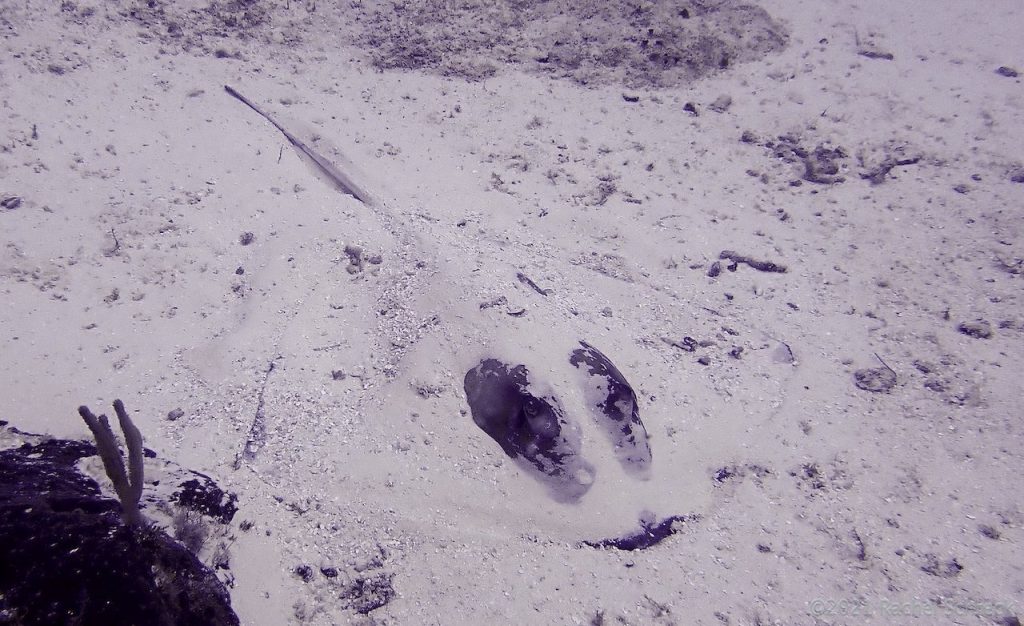
We also have tons of small yellow stingrays that often startle you by hiding out under a layer of sand, though they can also be seen fluttering around the coral reefs on both shallow and deep dives, and especially in wide sea grass areas.
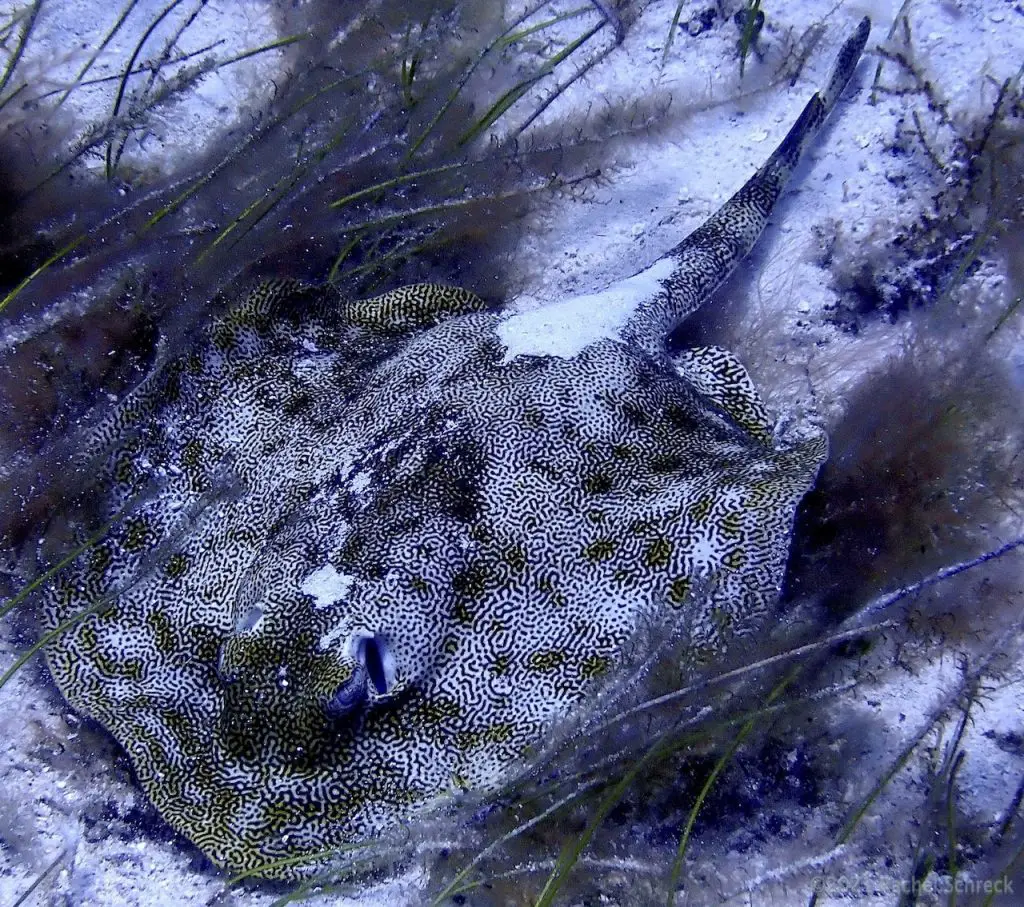
Rainbow and Midnight Parrotfish
Parrotfish are listed below, but I think these two types of impressive parrotfish deserve a special place in this sub-section.
Not only are they of a significantly larger size than our more common parrotfish, but they are two of our most rare and beautiful parrotfish to encounter.
Consider yourself lucky if you get a good glimpse of these fish. Not easy to photograph, though, at least with a simple setup.
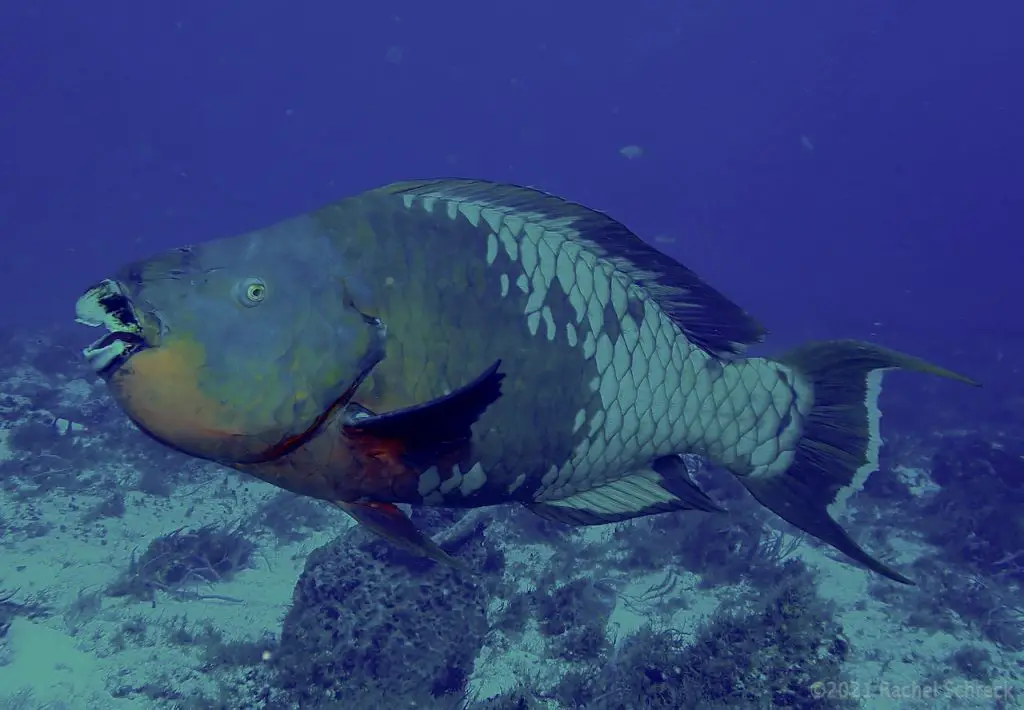
Regardless, it’s worth it just to try to stay calm so you don’t spook them away and then just watch their somewhat brutal grace as they dip down for big chomps out of the reef, float up a bit, and then dive back down for more. Awesome.
Mid-Range Subjects: Cozumel’s Tropical Coral Reef Fish
On to the tropical countless reef fish!
It’s impossible to count and list them all, but underwater photographers will see oodles of tropical reef fish, on all dives sites – both deep and shallow.
Here are just some of the various warm-water fish you can see while diving in Cozumel, Mexico.
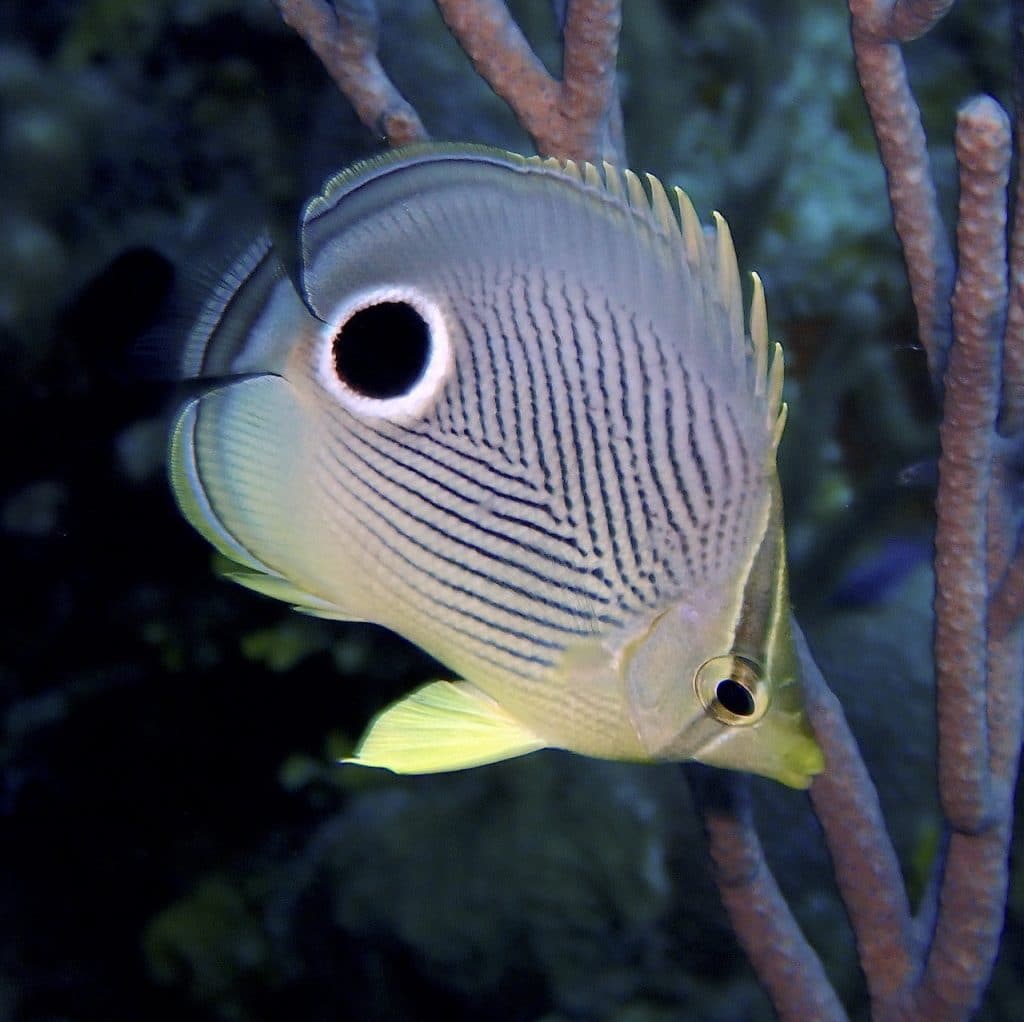
- Beautiful pairs of French, Grey, and Queen Angelfish (always travel in pairs – learn more about that in this related post)
- Blue chromis
- All kinds of damselfish – some pretty, some nasty (photographers beware…luckily they’re small)
- Barracuda
- Grouper of various colors, stripes and spots
- Jacks
- Grunts
- Goatfish
- Hogfish
- Squirrelfish
- Ocean triggerfish
- Queen triggerfish
- Parrotfish in every color of the rainbow
- Porcupinefish
- Moray eels (read more about our Cozumel eels HERE)
- Squirrelfish
- Trumpetfish (and sometimes even the rare coronet fish)
- Blennies
- Gobies
- Jawfish
The list goes on and on….
Spotted Drum Fish
Another of our most special fish and an especially good subject for underwater photographers are the spotted drum fish.
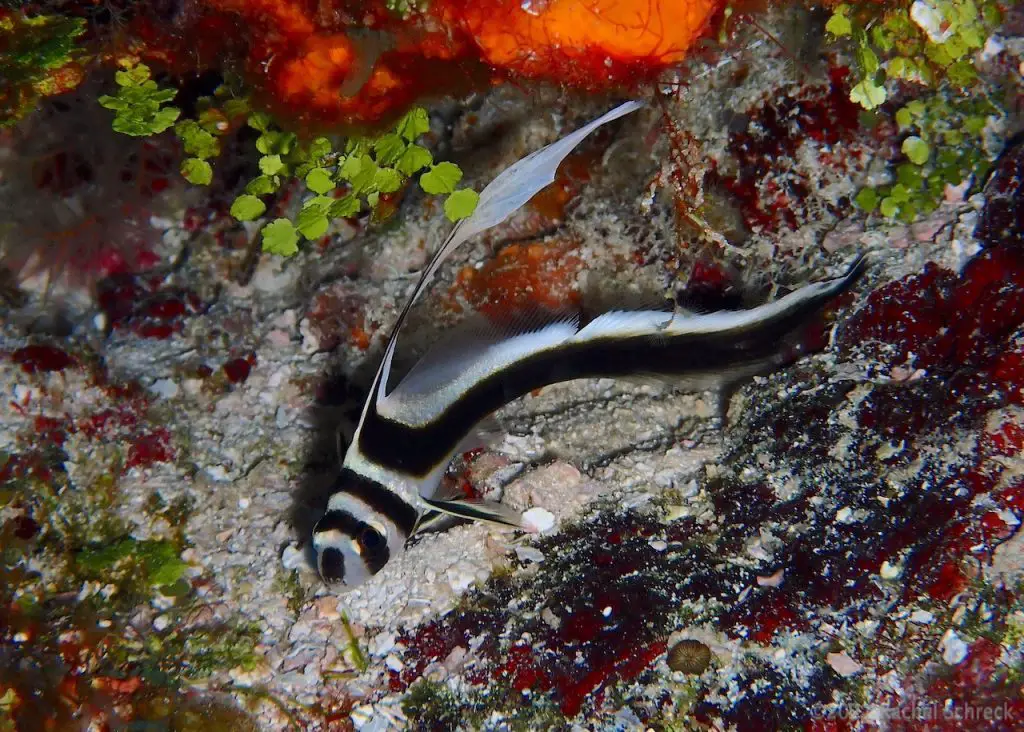
We often encounter the dainty dancing juveniles, with their ribbon-like dorsal fins fluttering (and making a clean shot a bit of a challenge!).
A rarer treat is finding an adult spotted drumfish, who look very different after they’ve matured, and tend to hide out in caves and coral outcroppings.
Please read more about drumfish in THIS POST.
Cozumel’s Endemic Spleandid Toadfish
Last but certainly not least, no roster of tropical reef fish in Cozumel would be complete without mentioning our resident endemic “mascot” fish – the splendid toadfish (Sanopus splendidus).
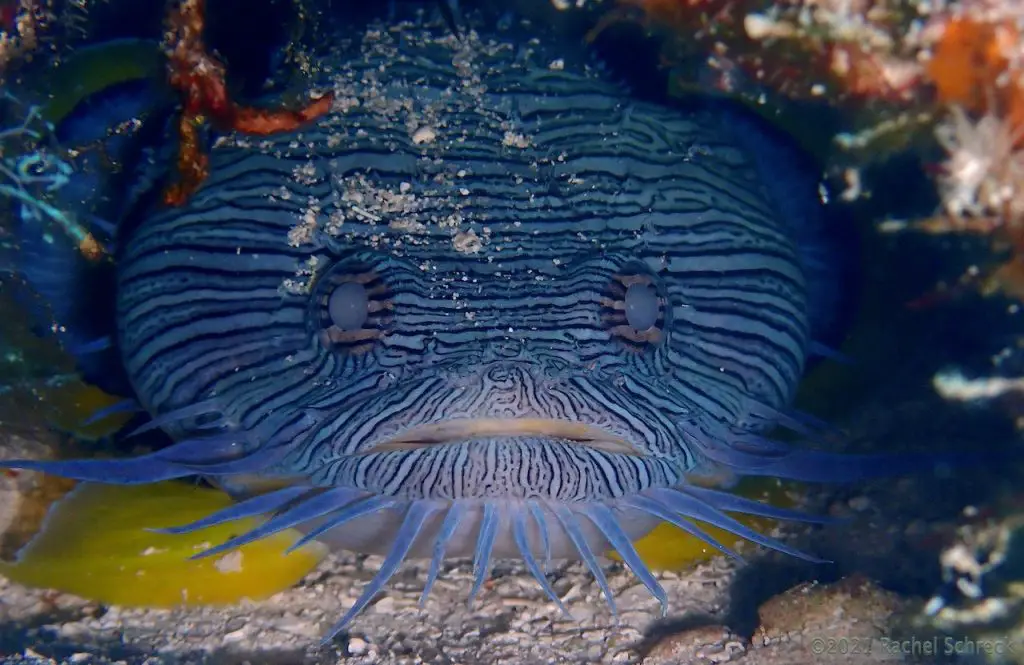
This feature article HERE explains all about this incredible creature.
Where to find it, and how it might take an expert guide and a Cozumel night dive to really see one – and get a great underwater shot of one – in person.
The fish that are commonly seen on our reefs are similar to what you’d find in many of the deep and shallow ocean dive sites around the world.
Check Out the Amazing Colorful Sponges
Tip #6 – Look in all the sponges
The coral formations that are seen in this part of the Mesoamerican Barrier Reef are just spectacular.
From the giant brain coral to the narrow tube corals, there is just so much to see and admire.
Marine sponges are also a major part of this ecosystem, and sometimes get taken for granted.
Huge barrel sponges and others here are healthy, plentiful, and colorful on the reefs, and come in many different sizes and shapes.
They make incredible photography subjects all on their own.
But for my money? The even better thing about sponges for underwater photographers is that they provide excellent shelter for many little critters.
My personal favorite sponge dweller is this somewhat rare peppermint shrimp I find here from time to time (shown below).
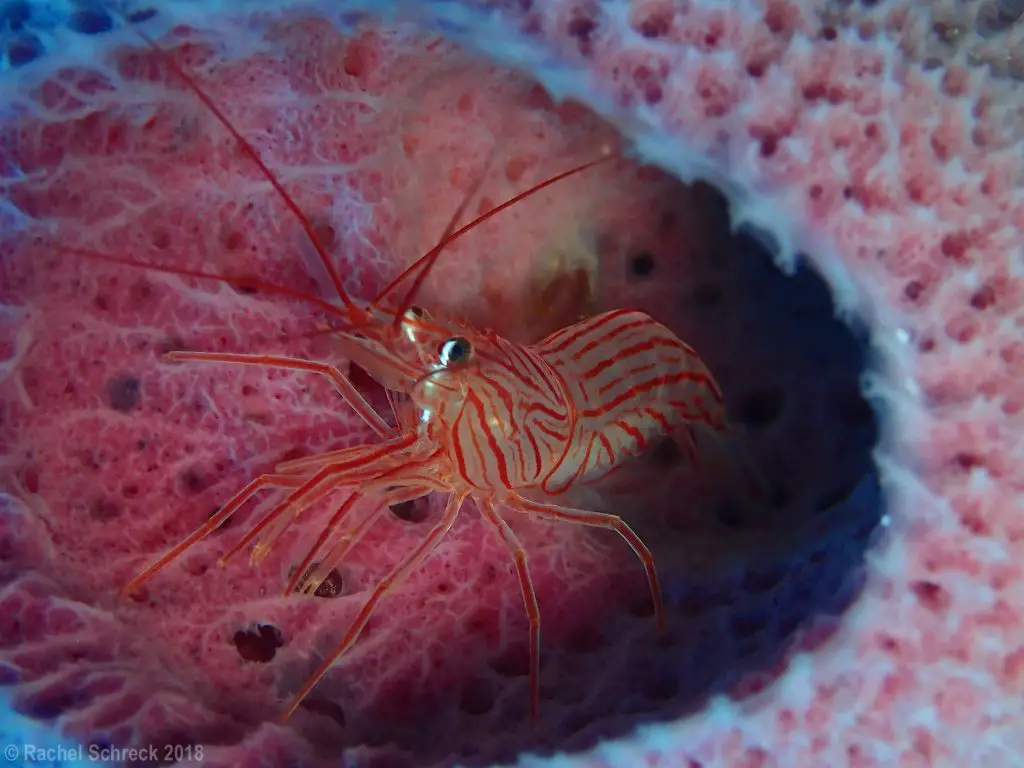
If you’re into underwater macro photography, don’t forget to peek inside as many of the various tube and vase sponges that you see. You’re very likely to find a fun surprise of a macro critter hiding inside.
This brings me to my final point about the excellence of
The macro marine life!
Cozumel is Crazy with Macro Marine Critters
Tip #7 – Change your thinking that Cozumel doesn’t have good macro (it most definitely does)
If you like macro marine life and underwater macro photography, link to the following posts after this for more on some of our favorite macro critters:
- Basket Stars and Sea Stars of Cozumel
- Various types of Ornate Cleaner Shrimp
- Sea Slugs and Nudibranchs
- Macro Marine Eggs
- The Eels of Cozumel
- Unusual Juveniles
- Sea Urchins – Look but Don’t Step
- The One and Only Splendid Toadfish
Our magnificent local macro and muck-diving:
If you’re coming to do some
Here’s a full guest post I did for Moziak Cameras on the best places to scout for Cozumel macro life.
It may be well worth hiring a private dive guide so you have the time to slow down and poke around a bit, too.
If you’re patient and good at keeping your eyes peeled for the little teeny critters that show up in the strangest places, you will be sure to find a lot of great macro animals to photograph.
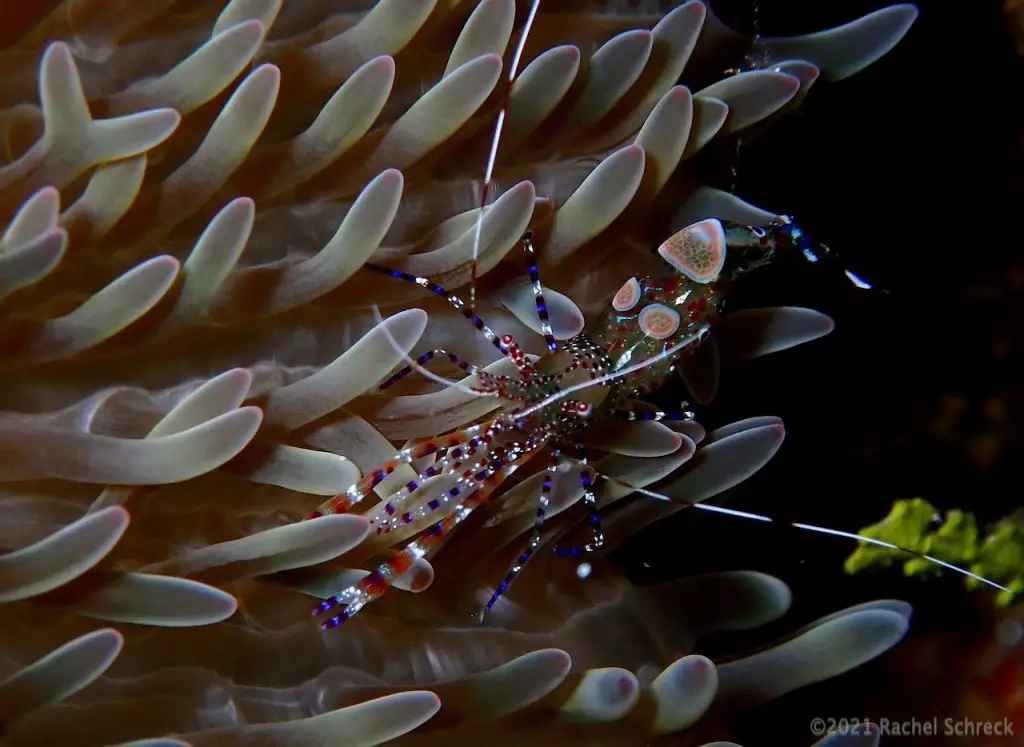
Tip #8 – Best Places to Look for Macro Marine Life on Dive Sites
I will do another post on this, but for starters here are some of the best local macro subjects, and what you’re likely to find in or near them:
Sea Anemones
Squat anemone shrimp
Banded Clinging Crabs
Arrow Crabs
Spotted Cleaner Shrimp (see image, above, for a good example)
Sun Anemones
Corkscrew Anemones
Pedersen Cleaning Shrimp
Pistol Shrimp
Arrow crabs
Barrel and Vase Sponges
Red reef crabs
Decorator Crabs
Larger hermit crabs
Two-claw shrimp
Peppermint shrimp
Tiny hermit crabs
Branching Corals
Sea Snails
Elkhorn Coral Crabs
Sandy Bottom Areas
Lined sole
Squat lobsters (tiny)
Scorpionfish (large and small)
Giant hermit crabs
Flapping dingbat bubble snails
The list goes on and on and on…and on…
Tip #9 – Don’t Doubt the Underwater Photography Opps in Cozumel
As you can see, with a wide variety of deep and shallow dive sites, varying coral formations, and lots of interesting marine life, Cozumel is a great place for divers with cameras to practice their new skills, or for seasoned pros to find some print-worthy shots.
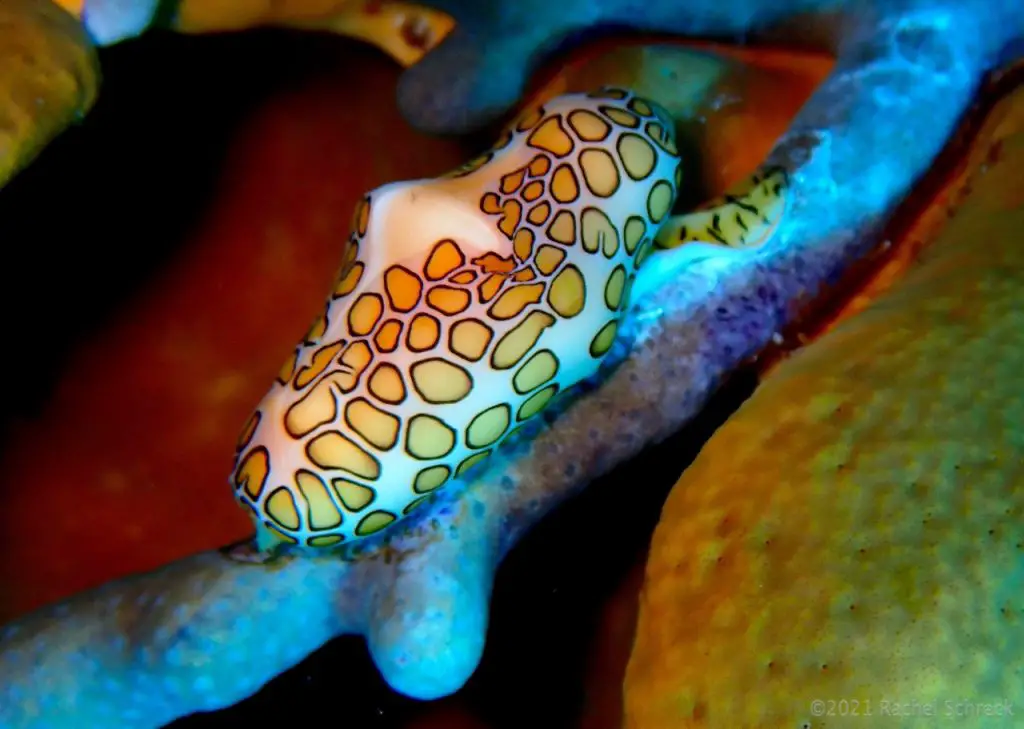
It’s a wonderful place to pick up the hobby and learn, first off. I’m into minimal gear, too, so check out this set of recommended photography equipment that won’t break the bank, and can have you scouring these awesome dive sites for more cool little critters than you can count.
- Easy to use
- Easy to pack
- Easy on the wallet
- Durable, waterproof, dustproof
CozInfo’s Cozumel Packing Essentials:
|
3.5
|
3.5
|
3.5
|
3.5
|
|
$19.99
|
$249.00
|
$59.95
|
$22.99
|

